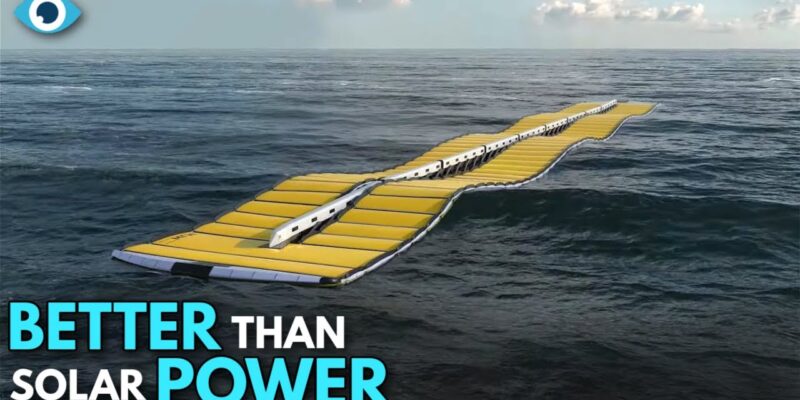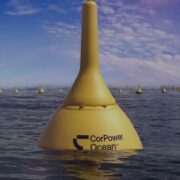
Harnessing Wave Energy: The Waveline Magnet
Exploring a new device that could revolutionize wave energy harnessing.
The Need for Greener Energy Solutions
In today’s world, the pressing need for greener energy solutions has become increasingly evident. The global search for lower carbon emissions, coupled with the advancements in the renewable energy sector, highlights the urgency for transitioning towards sustainable energy sources. However, despite the progress made, there are significant challenges in competing with traditional fossil fuels that still dominate the energy landscape.
Global Search for Lower Carbon Emissions
The detrimental impact of carbon emissions on the environment has prompted a worldwide effort to reduce greenhouse gas emissions and combat climate change. Countries, organizations, and individuals are recognizing the need to transition towards greener energy solutions to mitigate the escalating effects of global warming.
The Paris Agreement, signed by numerous countries, underscores the commitment to limit global warming and pursue efforts to keep the temperature rise below 2 degrees Celsius. This agreement has catalyzed initiatives to shift towards renewable energy sources and decrease reliance on fossil fuels.
Rising Awareness and Advocacy
Public awareness about the environmental consequences of carbon emissions has been steadily increasing. Advocacy groups, environmentalists, and scientists have been instrumental in raising awareness about the need for sustainable energy practices. The push for greener energy solutions is not just a trend but a fundamental shift in how energy is produced and consumed globally.
- Initiatives like Earth Hour and Earth Day raise awareness about the importance of reducing carbon footprints.
- Campaigns promoting energy conservation and renewable energy adoption have gained traction in communities worldwide.
Renewable Energy Sector Advancements
The rapid advancements in renewable energy technologies have paved the way for a cleaner and more sustainable energy future. Solar, wind, hydroelectric, geothermal, and biomass energy sources offer viable alternatives to fossil fuels and have been gaining prominence in the global energy mix.
Solar Energy
Solar energy has emerged as a frontrunner in the push for renewable energy solutions. The declining costs of solar panels, coupled with technological innovations, have made solar power more accessible and cost-effective. From rooftop solar installations to utility-scale solar farms, solar energy is revolutionizing the way electricity is generated.
The abundance of sunlight makes solar energy a reliable and abundant source of clean power.
Wind Energy
Wind energy is another key player in the renewable energy sector. Wind turbines harness the power of the wind to generate electricity, offering a sustainable and renewable energy source. Advancements in wind turbine technology have increased energy efficiency and made wind power a competitive option for electricity generation.
- Offshore wind farms have the potential to significantly expand the capacity for wind energy generation.
- Wind turbines with larger rotor diameters and taller towers can capture more wind energy and increase output.
Challenges in Competing with Fossil Fuels
Despite the progress made in promoting greener energy solutions, the renewable energy sector still faces challenges in competing with traditional fossil fuels. The entrenched infrastructure, economic incentives, and energy policies that support fossil fuel industries present significant barriers to the widespread adoption of renewable energy sources.
Economic Considerations
One of the primary challenges in transitioning to greener energy solutions is the economic factor. While the costs of renewable energy technologies have been declining, fossil fuels continue to enjoy subsidies and cost advantages that make them more economically viable in the short term.
The long-term benefits of investing in renewable energy, such as sustainability, energy independence, and environmental preservation, outweigh the initial costs.
Grid Integration and Storage
The variability of renewable energy sources, such as solar and wind, poses challenges for grid integration and energy storage. Unlike fossil fuels, which provide consistent power output, renewable energy generation is dependent on factors like weather conditions and daylight hours.
Advancements in energy storage technologies, such as batteries and pumped hydro storage, are crucial for overcoming the intermittency of renewable energy sources and ensuring grid stability.
Introduction to the Waveline Magnet
Welcome to the exciting world of the Waveline Magnet, an innovative device that replicates a floating spine and opens up a realm of possibilities in various industries. This revolutionary technology has the potential to redefine energy production and enhance marine farming practices, making a significant impact on the way we harness resources from the ocean.
Innovative Device Replicating a Floating Spine
The Waveline Magnet is a cutting-edge invention inspired by the graceful movements of the ocean. By mimicking the flexibility and resilience of a floating spine, this device can adapt to the dynamic forces of water currents with unparalleled efficiency. The design of the Waveline Magnet allows it to sway and bend in response to the ebb and flow of the waves, maximizing its energy-capturing capabilities.
Unlike traditional rigid structures that are often overwhelmed by the relentless power of the sea, the Waveline Magnet harmoniously integrates with its environment, harnessing the energy of the ocean in a sustainable and non-intrusive manner. This adaptability not only ensures optimal performance but also minimizes the environmental impact of energy production activities in marine settings.
The flexibility of the Waveline Magnet’s design is truly remarkable, enabling it to withstand harsh conditions and turbulent waters without sacrificing its functionality. By closely replicating the natural movements of marine organisms, this device sets a new benchmark for efficiency and durability in oceanic technologies.
Potential Applications in Energy Production
One of the most promising applications of the Waveline Magnet lies in the field of energy production. By capturing the kinetic energy present in ocean waves, this device can generate electricity in a renewable and environmentally friendly manner. Unlike fossil fuels, which contribute to pollution and climate change, wave energy is abundant, clean, and readily available along coastal regions worldwide.
The Waveline Magnet’s innovative design allows it to convert the mechanical energy of wave motion into electrical power with high efficiency. This sustainable energy source has the potential to reduce our reliance on traditional fossil fuels and pave the way for a more sustainable energy future. By harnessing the power of the ocean, we can create a reliable and eco-friendly energy supply that benefits both present and future generations.
Furthermore, the scalability of the Waveline Magnet makes it suitable for a wide range of applications, from small-scale power generation for remote communities to large-scale energy production for industrial purposes. This versatility opens up new possibilities for decentralized energy systems and grid resilience, fostering energy independence and security in coastal areas.
Potential Applications in Marine Farming
In addition to energy production, the Waveline Magnet also holds great potential for revolutionizing marine farming practices. By leveraging its unique design and adaptability, this device can enhance aquaculture operations and improve the efficiency of seafood production in coastal waters.
Marine farming, including fish farming and seaweed cultivation, plays a crucial role in meeting the growing demand for seafood while alleviating pressure on wild fish stocks. However, traditional aquaculture methods often face challenges such as space limitations, water quality issues, and environmental impact. By integrating the Waveline Magnet into marine farming systems, these challenges can be overcome through innovation and sustainability.
The dynamic movements of the Waveline Magnet not only generate energy but also create a conducive environment for marine organisms to thrive. The gentle swaying motion of this device can improve water circulation, oxygen levels, and nutrient distribution in aquaculture settings, supporting the health and growth of fish and other aquatic species.
Furthermore, the Waveline Magnet’s ability to adapt to changing sea conditions makes it ideal for offshore aquaculture applications where traditional fixed structures are impractical. By providing a stable and nurturing environment for marine life, this device can unlock new possibilities for sustainable seafood production and contribute to food security and economic development in coastal communities.
Features of the Waveline Magnet
The Waveline Magnet is a revolutionary technology that offers a range of advanced features and capabilities in the field of wave energy extraction. Let’s delve into the key features that make the Waveline Magnet stand out from traditional wave energy systems:
Floating Platforms Connected Like a Spine
The Waveline Magnet is designed with floating platforms that are interconnected in a unique spine-like structure. This innovative design allows the system to be more stable and efficient in harnessing wave energy. By connecting the platforms in this manner, the system can better withstand the forces of the waves and ensure continuous operation even in challenging sea conditions.
Ability to Track Waves Without Disruption
One of the standout features of the Waveline Magnet is its ability to track waves without any disruption to its operation. The system utilizes advanced sensors and control mechanisms to adjust its position and orientation in real-time, ensuring that it is always aligned with the incoming waves. This capability maximizes the energy extraction efficiency of the system and allows it to adapt to changing wave patterns seamlessly.
Control Over Energy Extraction
Unlike traditional wave energy systems that may struggle to optimize energy extraction, the Waveline Magnet offers precise control over the amount of energy harvested. Through sophisticated algorithms and monitoring systems, the Waveline Magnet can adjust its energy extraction levels according to the wave conditions, ensuring maximum efficiency and output. This level of control sets the Waveline Magnet apart as a leading technology in the wave energy sector.
Use of Plastics for Cost Efficiency
Cost efficiency is a crucial aspect of any renewable energy technology, and the Waveline Magnet addresses this by utilizing plastics in its construction. Plastics offer a lightweight and durable alternative to traditional materials, reducing manufacturing costs and overall system expenses. Additionally, the use of plastics does not compromise the performance or longevity of the system, making it an economically viable solution for wave energy extraction.
Flexibility and Recyclable Materials
The Waveline Magnet prioritizes flexibility and sustainability through the use of recyclable materials in its construction. By incorporating recyclable components, the system minimizes its environmental impact and supports circular economy practices. Moreover, the flexibility of the materials allows for easier maintenance and future upgrades, ensuring that the Waveline Magnet remains a cutting-edge and environmentally friendly technology in the long run.
In conclusion, the Waveline Magnet represents a significant advancement in the field of wave energy extraction, offering a host of features that set it apart from conventional systems. From its innovative design to its precise control mechanisms and sustainable materials, the Waveline Magnet embodies the future of renewable energy technologies.
Testing and Potential Impact
When it comes to wave energy generation, the potential impact is vast. With the ability to produce up to 100 megawatts of power, this technology holds great promise for sustainable energy production. The successful laboratory and sea trials conducted in Cyprus have proven the efficacy of this solution, paving the way for further development and implementation.
One of the key advantages of wave energy generation is its cost-effectiveness. By harnessing the power of the ocean waves, this technology offers a renewable and efficient way to generate electricity. The scalability of this solution makes it suitable for a wide range of applications, from small-scale residential use to large-scale industrial projects.
“The successful testing and potential impact of wave energy generation highlight its significance in the renewable energy landscape.”
TL;DR
Wave energy generation has the potential to produce up to 100 megawatts of power, as demonstrated by successful trials in Cyprus. This technology offers a cost-effective and sustainable solution for electricity generation.













